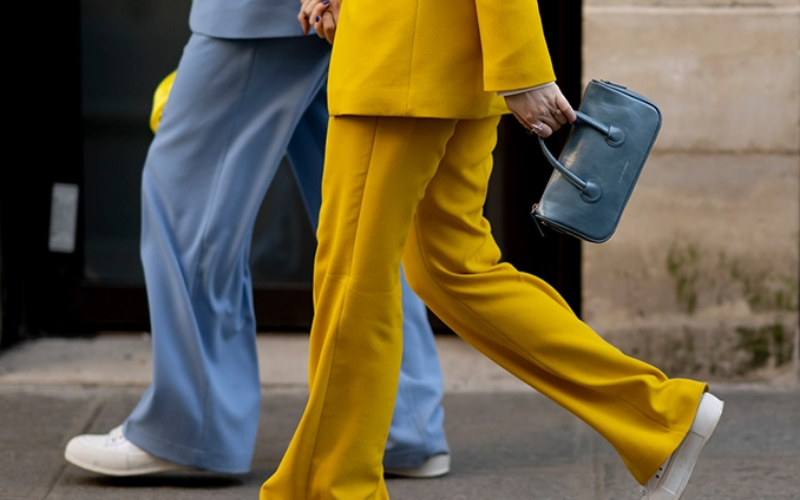Labia cleavage, also known as “camel toe,” refers to the visibility of the labia majora or minora through tight-fitting clothing, resulting in a cleavage-like effect. It is a natural occurrence and can happen to anyone, regardless of body shape or size. Labia cleavage is often a result of wearing clothing that is too tight or designed in a way that accentuates the genital area.
The visibility of labia cleavage is often a source of embarrassment or discomfort for many individuals, but it’s important to understand that it is a normal and natural part of the human body. Labia cleavage should not be stigmatized or sexualized, but rather accepted as a normal variation in the way our bodies appear in different types of clothing.
Labia cleavage is not limited to a specific age group, body type, or gender. It can occur in various situations, such as when wearing leggings, swimsuits, or certain types of underwear. While some people may feel self-conscious about labia cleavage, it’s crucial to remember that our bodies come in all shapes and sizes, and there is no “right” or “wrong” way for them to look.
The history and controversy surrounding labia cleavage
The visibility of labia cleavage has sparked controversy and debate throughout history. In many cultures, the exposure of the genital area, including the labia, has been regarded as taboo or inappropriate. This has led to the stigmatization of labia cleavage and the perpetuation of unrealistic beauty standards.
In recent years, there has been a growing movement to challenge these societal norms and promote body positivity. Advocates for body acceptance argue that the visibility of labia cleavage should not be cause for shame or judgment. Instead, it should be embraced as a natural aspect of the human body.
Despite these efforts, labia cleavage continues to be a topic of contention, especially in the fashion and entertainment industries. Some argue that the portrayal of labia cleavage in media and advertising contributes to the objectification of women’s bodies, while others believe that it is a form of self-expression and body empowerment.
Labia cleavage in fashion and media
The fashion industry has played a significant role in shaping perceptions of labia cleavage. Tight-fitting clothing, such as yoga pants and leggings, has become increasingly popular, leading to greater visibility of the labia through clothing. While some view this as a fashion statement, others criticize it for perpetuating unrealistic beauty standards and promoting the objectification of women’s bodies.
In media, the portrayal of labia cleavage has been a subject of debate, with some arguing that it is sexualized for the male gaze, while others see it as a celebration of body diversity. The representation of labia cleavage in popular culture has varied, from being censored and airbrushed to being embraced as a symbol of confidence and self-acceptance.
As the fashion and media landscapes continue to evolve, there is an ongoing conversation about the portrayal of labia cleavage and its impact on body image and self-esteem. It is essential for the fashion and media industries to consider the diverse perspectives on labia cleavage and strive for more inclusive and body-positive representations.
The anatomy of labia cleavage
Understanding the anatomy of labia cleavage is essential to dispel any misconceptions or stigma surrounding this natural phenomenon. The labia majora and minora are part of the external female genitalia and vary in size, shape, and appearance from person to person. When the labia are visible through clothing, it is often due to the tightness or transparency of the fabric.
The visibility of labia cleavage can also be influenced by factors such as body posture, movement, and the type of clothing being worn. It’s important to recognize that labia cleavage is not a sign of immodesty or promiscuity but rather a result of natural anatomical variations and the clothing choices individuals make.
By understanding the anatomy of labia cleavage, we can foster a more informed and respectful dialogue about the human body and promote acceptance of its diverse forms. Educating oneself and others about the natural variations of the human body can help dispel myths and misconceptions surrounding labia cleavage.
Labia cleavage and body positivity
The visibility of labia cleavage has become intertwined with the broader movement for body positivity and self-acceptance. In a society that often imposes unrealistic beauty standards, embracing labia cleavage can be a form of reclaiming agency over one’s body and challenging societal norms.
Body positivity encompasses the acceptance and celebration of all body types, including those that may not align with traditional beauty ideals. By embracing labia cleavage, individuals are challenging the notion that their bodies should conform to narrow standards of beauty and desirability.
It is important to recognize that body positivity is not limited to the visibility of labia cleavage but extends to all aspects of body diversity. Embracing labia cleavage can be a step toward fostering a more inclusive and accepting society where individuals are valued for their uniqueness and inherent worth.
Labia cleavage and sexual health
While labia cleavage is a natural occurrence, it’s essential to consider its potential impact on sexual health. Wearing tight-fitting clothing for extended periods can create a warm and moist environment, which may predispose individuals to yeast infections or irritation in the genital area.
To promote sexual health and comfort, individuals experiencing labia cleavage can consider wearing breathable and appropriately sized clothing. It’s important to prioritize comfort and well-being when selecting attire, especially in situations where prolonged physical activity or perspiration may occur.
Additionally, open conversations about sexual health and hygiene can help dispel any shame or discomfort associated with labia cleavage. By fostering a supportive and informed environment, individuals can seek guidance and resources to maintain optimal sexual health while embracing their bodies.
Embracing labia cleavage: Tips and advice
For individuals who may feel self-conscious about the visibility of labia cleavage, there are various strategies to promote self-confidence and comfort. Choosing clothing made from breathable fabrics and with a proper fit can minimize the prominence of labia cleavage while ensuring comfort and mobility.
Additionally, seeking out brands and designers that prioritize inclusivity and diversity in their clothing lines can help individuals find attire that aligns with their personal preferences and values. By selecting clothing that reflects their individual style and comfort, individuals can feel empowered and confident in their appearance.
Engaging in open and supportive conversations with friends, family, or mental health professionals can also provide individuals with the opportunity to express their concerns and seek reassurance. Creating a supportive network and seeking guidance from trusted sources can contribute to a more positive and affirming outlook on labia cleavage.
Labia cleavage in popular culture
The portrayal of labia cleavage in popular culture has been a subject of both fascination and controversy. From fashion runways to celebrity red carpets, the visibility of labia cleavage has garnered attention and sparked discussions about body confidence and representation.
In recent years, there has been a notable shift toward embracing labia cleavage as a symbol of body empowerment and self-expression. Many individuals and public figures have spoken out in support of embracing the natural variations of the human body and challenging societal expectations of physical perfection.
Popular culture has the potential to influence perceptions and attitudes toward labia cleavage, making it crucial for media and entertainment industries to consider the impact of their representations. By showcasing diverse body types and promoting inclusivity, popular culture can contribute to a more accepting and affirming environment for individuals of all backgrounds.
Debunking myths about labia cleavage
There are several myths and misconceptions surrounding labia cleavage that contribute to its stigmatization and misunderstanding. One common myth is that labia cleavage is inherently inappropriate or suggestive, when in reality, it is a natural occurrence that should not be subject to judgment or shame.
Another myth is that labia cleavage is exclusive to certain body types or clothing choices, perpetuating the idea that it is a result of immodesty or lack of discretion. In truth, labia cleavage can occur in various individuals and is not indicative of their character or values.
By debunking these myths and misconceptions, we can foster a more informed and respectful discourse about labia cleavage. Challenging stigmatizing beliefs and promoting understanding can contribute to a more inclusive and accepting environment for individuals who experience labia cleavage.
Conclusion
In conclusion, understanding labia cleavage is an essential part of promoting body positivity, acceptance, and sexual health. By recognizing the natural and diverse variations of the human body, we can work toward creating a society that celebrates individuality and inclusivity.
It is crucial to challenge societal norms and beauty standards that perpetuate shame and judgment around labia cleavage. Embracing open conversations, debunking myths, and promoting body positivity can contribute to a more affirming and respectful environment for individuals of all backgrounds.
Ultimately, embracing labia cleavage is a step toward recognizing the inherent worth and beauty of all bodies, regardless of societal expectations or norms. By fostering a culture of acceptance and understanding, we can create a more inclusive and supportive world for everyone.
If you found this article informative and insightful, we encourage you to share it with others and continue the conversation about labia cleavage and body positivity. Let’s work together to promote acceptance and celebration of all body types.




